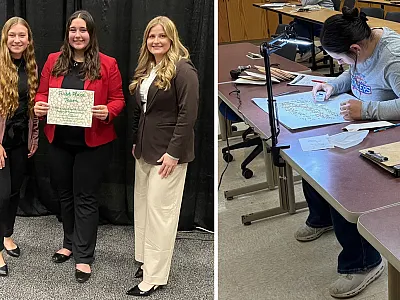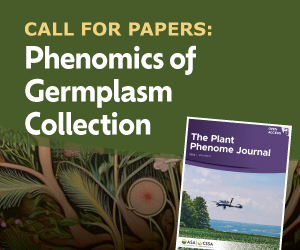Publications Update
Leveraging Transformational Agreements in Support of Open Access Publishing

Society members are becoming increasingly aware of the shift toward open science, most noticeably via open access publishing, as policy and funder mandates drive increased accessibility to research for all. ASA, CSSA, and SSSA publish 13 journals. Seven titles are hybrid subscription journals in which authors can publish for free or take advantage of an optional open access license for a fee. Six journals are published gold open access, which allows the content to be freely available online without a subscription or registration. The open access journals require payment of an article licensing fee before the accepted article can be published.
The journals owned and published by ASA, CSSA, and SSSA, in partnership with Wiley, fully support open science and are addressing the evolving market and increased requirements to provide a greater quantity of freely accessible journal content. While launching new open access journals or flipping existing titles to open access from the current subscription model are options, we have found a managed transition strategy over a period ensures better sustainability while supporting the needs of the research community. Transformational agreements (TAs) are the primary tool used to manage the transition to open access publishing for our authors. In January, 14 new TAs launched and 12 TA renewals were announced, making TAs a more common opportunity for authors.
What Is a Transformational Agreement?
A transformational agreement is established between a publisher and an institution, consortia, or even a whole country. It allows their researchers unlimited read access to a publisher’s portfolio of journals. which includes our journal collection, as well as funding to cover charges if choosing to publish open access. ASA, CSSA, and SSSA, through our partnership, are taking advantage of TAs negotiated by Wiley to facilitate the transition of our hybrid subscription journals towards open access with a sustainable outlook. Table 1 highlights active TAs around the world.
Table 1. Active transformational agreements as of 30 Jan. 2023.
Country | Consortium/ Institution name | Eligible institutions / Sites |
|---|---|---|
| Australia and New Zealand | CAUL | 52 |
| Australia and New Zealand | CSIRO | 1 |
| Austria | KEMO | 24 |
| Canada | CRKN | 71 |
| Cyprus | CLC | 8 |
| Czech Republic | CzechELib | 50 |
| Denmark | RDL | 30 |
| Finland | FinELib | 22 |
| France | Couperin | 130 |
| Germany | Projekt Deal | 707 |
| Greece | HEAL-Link | 43 |
| Hong Kong | JULAC | 6 |
| Hungary | EISZ | 13 |
| Ireland | IReL | 10 |
| Israel | MALMAD | 24 |
| Italy | Bibliosan | 68 |
| Italy | CRUI | 65 |
| Japan | JUSTICE | 18 |
| Mexico | UNAM | 1 |
| Netherlands | VSNU | 15 |
| Portugal | B-ON | 63 |
| Republic of Korea | NST | 25 |
| Singapore | NUS | 1 |
| Slovenia | CTK | 10 |
| South Africa | SANLiC | 24 |
| Spain | CRUE-CSIC | 68 |
| Sweden | Bibsam | 45 |
| Switzerland | CSAL | 46 |
| Thailand | Mahidol Univ. | 1 |
| United Kingdom | Jisc | 151 |
| United States | Baylor Univ. | 1 |
| United States | Big Ten Academic Alliance | 34 |
| United States | Boston College | 1 |
| United States | Brandeis Univ. | 1 |
| United States | Carnegie Mellon Univ. | 1 |
| United States | Carolina Consortium | 41 |
| United States | CDL | 5 |
| United States | Clark Univ. | 1 |
| United States | Colorado State Univ. | 1 |
| United States | Iowa State Univ. | 1 |
| United States | Johns Hopkins Univ. | 1 |
| United States | Loyola Univ. Chicago | 1 |
| United States | MIT | 1 |
| United States | Montana State Univ. | 1 |
| United States | OhioLINK | 81 |
| United States | Portland State Univ. | 1 |
| United States | Princeton Univ. | 1 |
| United States | SCELC | 61 |
| United States | Southern Methodist Univ. | 1 |
| United States | Syracuse Univ. | 1 |
| United States | Texas Christian Univ. | 1 |
| United States | Texas State Univ. | 1 |
| United States | Tulane Univ. | 1 |
| United States | UMass Lowell | 1 |
| United States | Univ. Alabama Birmingham | 1 |
| United States | Univ. of Georgia | 1 |
| United States | Univ. of Vermont | 1 |
| United States | U.S. Dept. of Energy | 3 |
| United States | VIVA (Virginia) Consortia | 55 |
| United States | Washington State Univ. | 1 |
What Are the Features of a Transformational Agreement?
Although each TA is different, they share some common terms and conditions, for example:
- The agreement term is often quite short (two to three years) to allow for market evolution.
- It includes a combination of read access and open access publishing.
- Support is provided for open access publishing in gold open access and hybrid journals.
- Most include licensing fee discounts to the institution or consortium.
- Research articles and reviews are normally qualified article types.
Our journals will experience positive impacts due to TAs, for example, in increased readership. As more and more articles are published open access, readership will expand. Open access articles are cited nearly twice as much as articles that are behind a paywall and accessed via a subscription, and they receive far greater visibility in news and social media. Compliance with policy and funder mandates and centralized payment structure eliminates author-based payments and will attract more submissions. Lastly, researchers at participating institutions can read, cite, and freely share the journal content.
Currently, our journal editors and editorial boards, in collaboration with the Publications Department staff, are working to meet goals for increased content output and readership as well as improved vital metrics utilizing strategies to improve quality, service to authors, and reputation. Editors are commissioning more content, developing special sections, and shaping topical issues to engage a changing scientific audience eager to learn through more than the written word. Transformational agreements are a motivating feature for authors around the world and provide opportunities for our journals to accelerate their evolution toward open science and meet the goals of researchers, authors, funding bodies, and policymakers.
Transformational agreement activity changes quickly. For more information and up-to-date details, please visit the author services web page via http://bit.ly/3RtYcP8 or by scanning the QR code.

Text © . The authors. CC BY-NC-ND 4.0. Except where otherwise noted, images are subject to copyright. Any reuse without express permission from the copyright owner is prohibited.











